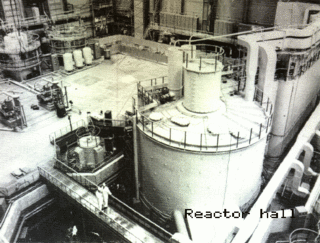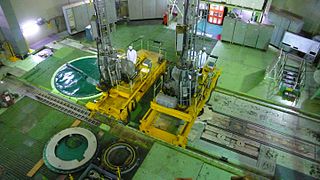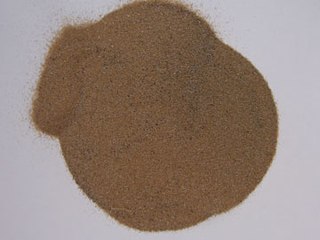Related Research Articles

A breeder reactor is a nuclear reactor that generates more fissile material than it consumes. These reactors can be fueled with more-commonly available isotopes of uranium and thorium, such as uranium-238 and thorium-232, as opposed to the rare uranium-235 which is used in conventional reactors. These materials are called fertile materials since they can be bred into fuel by these breeder reactors.

Phénix was a small-scale prototype fast breeder reactor, located at the Marcoule nuclear site, near Orange, France. It was a pool-type liquid-metal fast breeder reactor cooled with liquid sodium. It generated 590 MW of thermal power, and had a breeding ratio of 1.16, but normally had to be stopped for refueling operations every two months. Phénix continued operating after the closure of the subsequent full-scale prototype Superphénix in 1997. After 2004, its main use was investigation of transmutation of nuclear waste while also generating some electricity. Phénix was shut down in 2009.

A fast-neutron reactor (FNR) or fast-spectrum reactor or simply a fast reactor is a category of nuclear reactor in which the fission chain reaction is sustained by fast neutrons, as opposed to slow thermal neutrons used in thermal-neutron reactors. Such a fast reactor needs no neutron moderator, but requires fuel that is relatively rich in fissile material when compared to that required for a thermal-neutron reactor. Around 20 land based fast reactors have been built, accumulating over 400 reactor years of operation globally. The largest was the Superphénix sodium cooled fast reactor in France that was designed to deliver 1,242 MWe. Fast reactors have been studied since the 1950s, as they provide certain advantages over the existing fleet of water-cooled and water-moderated reactors. These are:

The Bhabha Atomic Research Centre (BARC) is India's premier nuclear research facility, headquartered in Trombay, Mumbai, Maharashtra, India. It was founded by Homi Jehangir Bhabha as the Atomic Energy Establishment, Trombay (AEET) in January 1954 as a multidisciplinary research program essential for India's nuclear program. It operates under the Department of Atomic Energy (DAE), which is directly overseen by the Prime Minister of India.

Indira Gandhi Centre for Atomic Research (IGCAR) is one of India's premier nuclear research centres. It is the second largest establishment of the Department of Atomic Energy (DAE), next to Bhabha Atomic Research Centre (BARC), located at Kalpakkam, 80 km south of Chennai, India. It was established in 1971 as an exclusive centre dedicated to the pursuit of fast reactor science and technology, due to the vision of Vikram Sarabhai. Originally, it was called Reactor Research Centre (RRC). It was renamed to Indira Gandhi Centre for Atomic Research (IGCAR) by the then Prime Minister of India Rajiv Gandhi in December 1985. The centre is engaged in broad-based multidisciplinary programme of scientific research and advanced engineering directed towards the development of fast breeder reactor technology in India.
Generation IVreactors are nuclear reactor design technologies that are envisioned as successors of generation III reactors. The Generation IV International Forum (GIF) – an international organization that coordinates the development of generation IV reactors – specifically selected six reactor technologies as candidates for generation IV reactors. The designs target improved safety, sustainability, efficiency, and cost. The World Nuclear Association in 2015 suggested that some might enter commercial operation before 2030.

A sodium-cooled fast reactor is a fast neutron reactor cooled by liquid sodium.

Madras Atomic Power Station (MAPS) located at Kalpakkam about 80 kilometres (50 mi) south of Chennai, India, is a comprehensive nuclear power production, fuel reprocessing, and waste treatment facility that includes plutonium fuel fabrication for fast breeder reactors (FBRs). It is also India's first fully indigenously constructed nuclear power station, with two units each generating 220 MW of electricity. The first and second units of the station went critical in 1983 and 1985, respectively. The station has reactors housed in a reactor building with double shell containment improving protection also in the case of a loss-of-coolant accident. An Interim Storage Facility (ISF) is also located in Kalpakkam.
The advanced heavy-water reactor (AHWR) or AHWR-300 is the latest Indian design for a next-generation nuclear reactor that burns thorium in its fuel core. It is slated to form the third stage in India's three-stage fuel-cycle plan. This phase of the fuel cycle plan was supposed to be built starting with a 300 MWe prototype in 2016.

The Fast Breeder Test Reactor (FBTR) is a breeder reactor located at Kalpakkam, Tamil Nadu, India. The Indira Gandhi Center for Atomic Research (IGCAR) and Bhabha Atomic Research Centre (BARC) jointly designed, constructed, and operate the reactor.

The BN-600 reactor is a sodium-cooled fast breeder reactor, built at the Beloyarsk Nuclear Power Station, in Zarechny, Sverdlovsk Oblast, Russia. It has a 600 MWe gross capacity and a 560 MWe net capacity, provided to the Middle Urals power grid. It has been in operation since 1980 and represents an improvement to the preceding BN-350 reactor. In 2014, its larger sister reactor, the BN-800 reactor, began operation.

The Beloyarsk Nuclear Power Station was the third of the Soviet Union's nuclear plants. It is situated by Zarechny in Sverdlovsk Oblast, Russia. Zarechny township was created to service the station, which is named after the Beloyarsky District. The closest city is Yekaterinburg.

The Department of Atomic Energy (DAE) is an Indian government department with headquarters in Mumbai, Maharashtra, India. DAE was established in 1954 with Jawaharlal Nehru as its first minister and Homi Bhabha as its secretary.
The Prototype Fast Breeder Reactor (PFBR) is a 500 MWe sodium-cooled, fast breeder reactor that is being constructed at Kokkilamedu, near Kalpakkam, in Tamil Nadu state, India. The Indira Gandhi Centre for Atomic Research (IGCAR) is responsible for the design of this reactor, the Advanced Fuel Fabrication Facility at the Bhabha Atomic Research Centre in Tarapur is responsible for MOX fuel fabrication and BHEL is providing technology and equipment for construction of the reactor. The facility builds on the decades of experience gained from operating the lower power Fast Breeder Test Reactor (FBTR). At first, the reactor's construction was supposed to be completed in September 2010, but there were several delays. The Prototype Fast Breeder Reactor is scheduled to be put into service in December 2024, which is more than 20 years after construction began and 14 years after the original commissioning date, as of December 2023. The project's cost has doubled from ₹3,500 crore to ₹7,700 crore due to the multiple delays. The construction was completed on 4th March 2024 with commencement of core loading of the reactor hence paving the way for the eventual full utilization of India’s abundant thorium reserves.

India's three-stage nuclear power programme was formulated by Homi Bhabha, the well-known physicist, in the 1950s to secure the country's long term energy independence, through the use of uranium and thorium reserves found in the monazite sands of coastal regions of South India. The ultimate focus of the programme is on enabling the thorium reserves of India to be utilised in meeting the country's energy requirements. Thorium is particularly attractive for India, as India has only around 1–2% of the global uranium reserves, but one of the largest shares of global thorium reserves at about 25% of the world's known thorium reserves. However, thorium is more difficult to use than uranium as a fuel because it requires breeding, and global uranium prices remain low enough that breeding is not cost effective.
Shivram Baburao Bhoje is a distinguished Indian nuclear scientist who worked in the field of fast-breeder nuclear reactor technology for forty years in the design, construction, operation, and research and development. The Indian government has honoured him with the Padma Shri in 2003, the fourth highest civilian award in India, for his distinguished service to science and engineering fields.
The Bharatiya Nabhikiya Vidyut Nigam Limited (BHAVINI) is a wholly owned Enterprise of Government of India under the administrative control of the Department of Atomic Energy incorporated on 22 October 2003 as a Public Limited Company under the Companies Act, 1956 with the objective of constructing and commissioning the first 500 MWe Fast Breeder Reactor (FBR) at Kalpakkam in Tamil Nadu and to pursue construction, commissioning, operation and maintenance of subsequent Fast Breeder Reactors for generation of electricity in pursuance of the schemes and programmes of Government of India under the provisions of the Atomic Energy Act, 1962. BHAVINI is currently constructing a 500MWe Prototype Fast Breeder Reactor at Kalpakkam, 70 km from Chennai.

Dr. Sekhar Basu was an Indian nuclear scientist who served as the chairman of the Atomic Energy Commission and Secretary to the Government of India, Department of Atomic Energy (DAE). He also served as the Director of Bhabha Atomic Research Centre (BARC), the Project Director of Nuclear Submarine Program, and later as the Chief Executive of the Nuclear Recycle Board at Bhabha Atomic Research Center. He was a recipient of India's fourth highest civilian honor Padma Shri in 2014.

The IPHWR-700 is an Indian pressurized heavy-water reactor designed by the NPCIL. It is a Generation III reactor developed from earlier CANDU based 220 MW and 540 MW designs. It can generate 700 MW of electricity. Currently there are two units operational, 6 units under construction and 8 more units planned, at a combined cost of ₹1.05 lakh crore (US$12 billion).
The Indian Pressurized Water Reactor-900 (IPWR-900) is a class of pressurized water reactors being designed by the Bhabha Atomic Research Centre (BARC) in partnership with the Nuclear Power Corporation of India Limited to supplement the Indian three-stage nuclear power programme.
References
- 1 2 "FBR-600 – India's Next-gen Commercial Fast Breeder Reactor [CFBR]". AA Me, IN. 4 October 2015. Retrieved 28 June 2016.
- ↑ "PM Modi witnesses commencement of Core Loading at India's first indigenous Prototype Fast Breeder Reactor at Kalpakkam, Tamil Nadu". newsonair.gov.in. Retrieved 4 March 2024.
- ↑ "Prototype Fast Breeder Reactor to be operational by end of 2025: Govt". The Economic Times. 4 December 2024. ISSN 0013-0389 . Retrieved 8 December 2024.
- ↑ Chellapandi, P.; Rao, P R Vasudeva; Kumar, Prabhat (2015). "Fast reactor programme in India". Pramana. 85 (3): 525–538. Bibcode:2015Prama..85..525C. doi:10.1007/s12043-015-1069-6. S2CID 119688291.
- ↑ Patel, Sonal (2 April 2024). "Long-Awaited Milestone: Fuel Loading Begins at India's Prototype Fast Nuclear Reactor". POWER Magazine. Retrieved 23 August 2024.